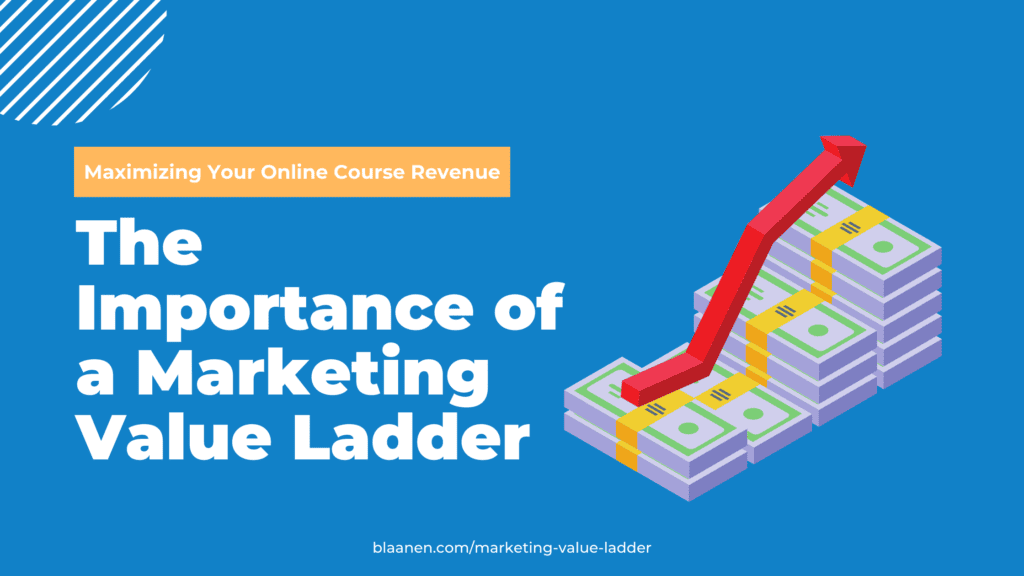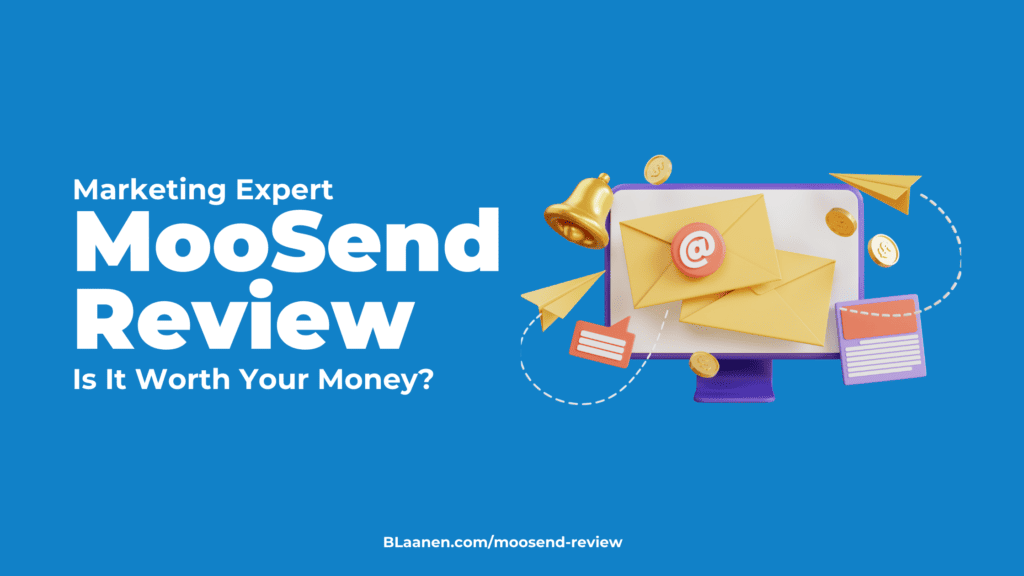As an online course creator, you’ve probably experienced the excitement of releasing a course, followed by the deflating realization that you’re not generating the revenue you’d hoped for.
When you stop to think about it, in today’s ever-competitive online learning market, simply having a great course is no longer enough. You need a strategic framework that helps you build your audience, attract leads, and develop audience relationships that allow you to extract the maximum value from each customer. Ultimately allowing you to earn more money.
This is where the marketing value ladder comes in. A marketing value ladder visualizes the sales funnel as a process of increasing the value of your audience over time by gradually introducing them to higher-priced and higher-value offerings.
Why is this important for course creators?
The answer is simple: implementing a marketing value ladder helps you segment your offerings based on your customers’ needs and financial capabilities. It enables you to cater to a wider range of customers, starting from those willing to try out your free or low-cost products, to those ready to invest in your premium courses and additional services.
More importantly, as existing customers climb your marketing value ladder, they gain more value and deepen their engagement with your personal brand, increasing their lifetime value and your profit margin.
A well-structured value ladder is more than just a strategy to make more money; it’s a road map to customer satisfaction and loyalty. Let’s explore the essential steps in crafting a powerful marketing value ladder for your online business and strategies for optimizing and promoting each step.

Table of Contents
ToggleUnderstanding the Marketing Value Ladder for an Online Business
If you’re interested in crafting your own value ladder model, it’s essential to comprehend the different stages and how they work together. Each stage of the value ladder serves a distinct role in the customer journey and is usually integrated into the sales funnel. You don’t have to include all these stages recommended below, it all depends on your business and on your purposes. Still, by understanding this, you can create a successful value ladder that suits your own business and target audience.
The Recommended Stages of a Marketing Value Ladder for Course Creators
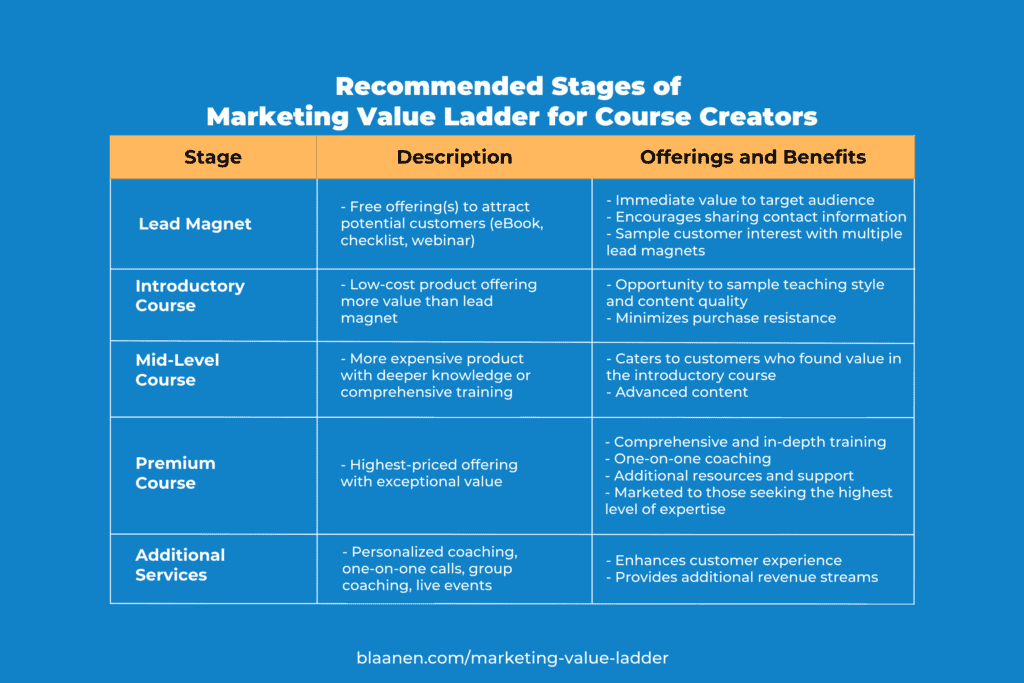
The beauty of the value ladder model is how each step builds on the one before it. As a potential customer moves up the ladder, they receive more value and become more invested in your brand. In fact, it’s not uncommon to just upsell and bump sales tactics to get new leads and customers to take multiple steps up the ladder at once. With each step and sale, your business generates more revenue creating a win-win situation for both the customer and the business.
Later in this article, we’ll discuss how to identify, create, manage, and promote each stage in your course creation process.
What Are the Benefits of a Marketing Value Ladder?
Marketing value ladders aren’t just tools for segmenting your product offerings. They are comprehensive strategies that offer many benefits, ensuring your online course business thrives and grows sustainably, as follows:
- Enhances customer satisfaction.
- Fosters loyalty.
- Boosts revenue.
- Positions your brand as a trusted authority.
Implementing it effectively could be the key to scaling your online course business to new heights.
This table allows readers to grasp the impact of a marketing value ladder on different facets of the business, providing a clearer understanding of its significance.
Marketing Value Ladder Benefits for Course Creators
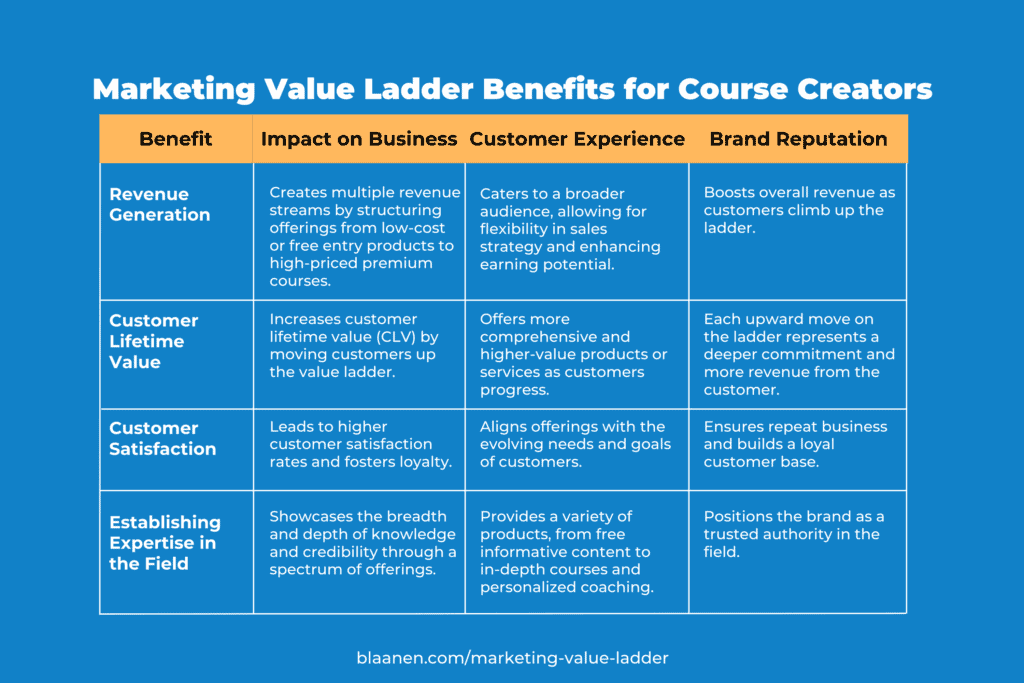
How to Develop Your Marketing Value Ladder
Creating a successful marketing value ladder requires more than just a simple framework; it demands a well-defined plan and unwavering commitment.
In the upcoming section, I will guide you through a few straightforward steps to help you build a robust and effective value ladder for your business. By following these steps, you’ll be on your way to strategically positioning your offerings and maximizing your revenue potential.
Where to Get Started Building a Marketing Value Ladder
Here’s a step-by-step guide to help you to start building your value ladder plus common pitfalls to avoid.
Building a Marketing Value Ladder for Course Creators
- Identify your target audience
- Map out the levels of your value ladder
- Keep consistent branding across all steps
- Build your value ladder
- Common mistakes to avoid
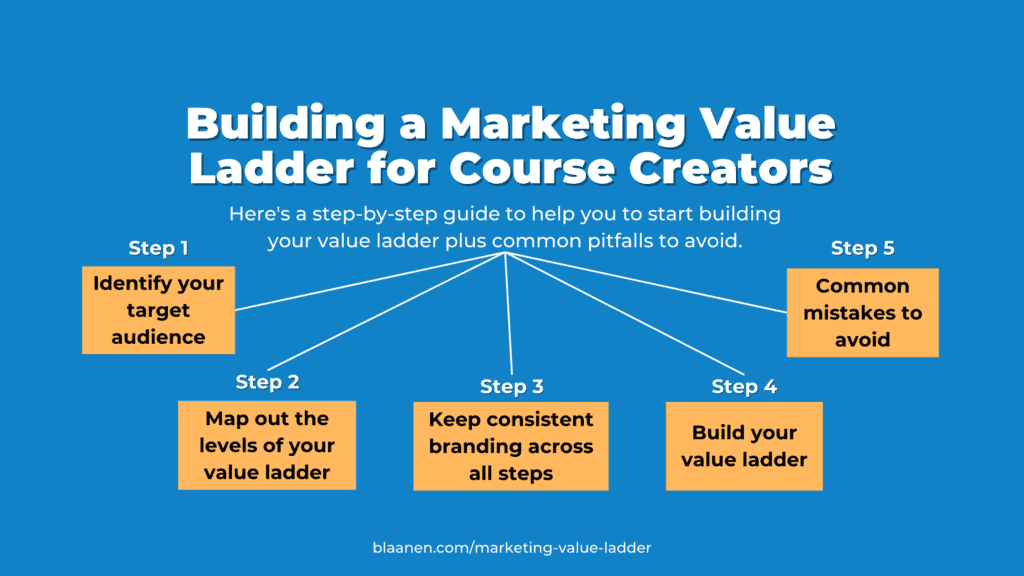
1. Identify Your Target Audience
Before you can build an effective value ladder, you need to understand who your customers are. Research your target audience and identify their needs, pain points, and goals. Identifying the target audience for your online business deserves a whole blog on its own, so we won’t get into it here. Use your audience information to create a value ladder that addresses their needs at each customer journey stage.
2. Map Out the Levels of Your Value Ladder
Start by creating a list of all your products and services, then organize them from the lowest cost (or free) to the highest cost. If you don’t already have various lead magnets or courses, I recommend starting with your core offering and working backward. This becomes your value ladder strategy. Remember that each ladder step should provide more value than the previous one.
3. Consistent Branding Across All Steps
As your customers move up the ladder, they must experience consistent branding. This includes your logo, colors, messaging, tone of voice, value proposition, and overall customer experience. Consistent branding builds trust and familiarity, encouraging customers to take the next step up the ladder. That said, don’t waste time developing your brand identity. Focus on delivering value and getting feedback. Iteration is key.
4. Start Building and Publishing Each Step of Your Value Ladder
Now that you have your target audience and value ladder strategy, it’s time to create your value ladder. Begin by focusing on your core product. It doesn’t necessarily have to be a high-end, premium offering. Instead, choose a product that allows you to develop your intellectual property and refine your strategies based on what resonates with your audience.
5. Common Mistakes to Avoid
Building a value ladder is an ongoing process that should evolve with your business. Keep your customer at the center of your value ladder strategy, and you’ll create a ladder that drives revenue and builds long-lasting customer relationships.
When building your value ladder, avoid these common mistakes:
- Not Providing Enough Value at Each Step: Each level of your value ladder should offer more value than the previous one. Don’t shortchange your customers at any step.
- Not Aligning the Ladder With Your Expertise: Each product or service you offer should align with your expertise and the needs of your target audience. Offering products or services outside your expertise can damage your credibility.
- Not Regularly Reviewing and Updating Your Value Ladder: As your business and customers evolve, so should your value ladder. Regularly review and update your value ladder to ensure it continues to meet the needs of your customers and your business.
Remember, perfection is not the goal at the beginning. What matters most is taking action, making progress, and observing what resonates with your audience. This is particularly crucial as you embark on promotion strategies, which we’ll delve into later in the discussion.
5 Essential Steps in Your Value Ladder
From crafting enticing lead magnets to offering high-value premium courses and services, you’ll discover how to strategically design your value ladder to attract, engage, and retain customers while driving revenue growth.
5 Essential Steps in Your Value Ladder
- Step 1: Lead Magnet
- Step 2: Introductory Course
- Step 3: Mid-Level Course
- Step 4: Premium Course
- Step 5: Consulting or Coaching Services
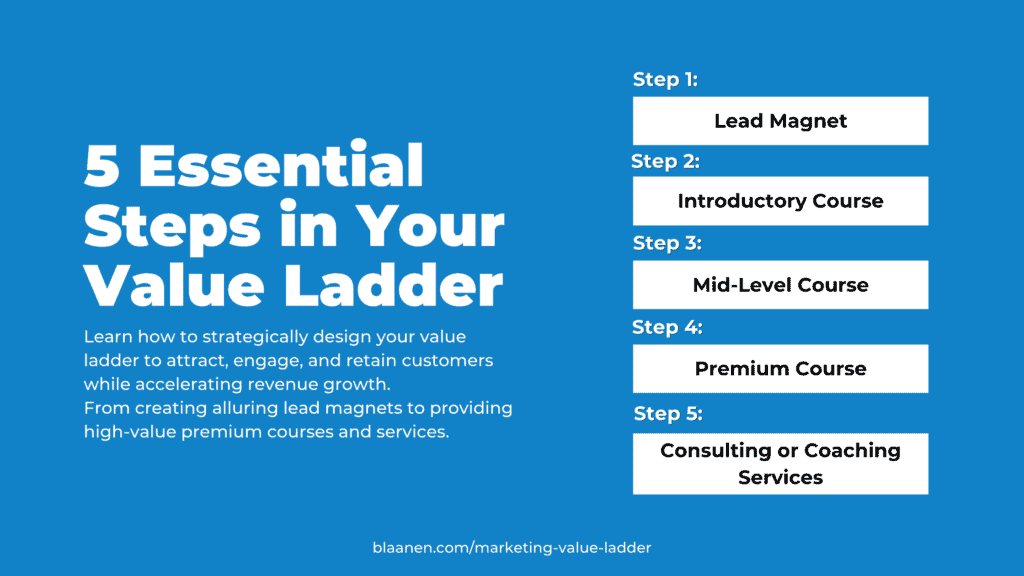
Step 1: Lead Magnet
A lead magnet is a critical component in the toolkit of a course creator. It’s essentially a free resource that you provide to prospective students, serving as the initial step on your marketing value ladder. Its primary purpose is to attract new leads by delivering immediate value in exchange for something – typically, their email address.
Crafting an effective lead magnet necessitates a comprehensive understanding of your target audience and what they need or want to learn. It should address a challenge they face or provide valuable knowledge they seek.
For instance, if your course centers around Python programming, your lead magnet could be:
- An e-book titled ‘Python Basics: The Ultimate Starter Guide,’
- A webinar ‘Cracking Python: From Beginner to Advanced,’
- A checklist ‘Key Python Commands Every Beginner Should Know.’
Developing a lead magnet must provide enough value to warrant the exchange of personal information. A lead magnet that resonates with your audience involves:
- Knowing them well
- Understanding their pain points
- Offering a resource that helps alleviate these issues.
Step 2: Introductory Course
An introductory course serves as the entry point to your brand’s unique pedagogy and subject matter expertise. It’s a low-cost or sometimes free offering that’s designed to convert potential customers – who’ve shown interest in your brand via the lead magnet – into actual customers.
This step is critical because it allows customers to experience your teaching style and content quality with minimal risk, which can encourage them to make more substantial investments in your offerings.
Creating an effective introductory course requires careful planning and execution:
- It must deliver clear, tangible value – the customer should walk away with new knowledge or skills that they can apply immediately.
- It should clearly showcase your brand’s expertise in the subject matter.
- It should subtly highlight the limitations of the introductory course and point towards the more comprehensive, intensive learning that’s available through your mid-level and premium courses.
For an online course business, the introductory course could take many forms:
- A series of video tutorials on a popular programming language like Python. This could include 10 short videos that teach the basics of Python, along with quizzes to test the learner’s understanding.
- A mini-course on graphic design consisting of 5 modules covering essential principles.
- An online digital marketing strategy workshop, including live presentations, Q&A sessions, and follow-up resources.
Step 3: Mid-Level Course
A mid-level course is in the middle of the spectrum within your product offerings. This level is designed to be more advanced than the introductory course but not as comprehensive or in-depth as your premium courses.
Mid-level courses are crucial to the marketing value ladder for course creators as they serve multiple functions:
- They represent an excellent opportunity for upselling. Customers who have purchased and enjoyed your entry-level course may seek additional content to deepen their understanding but may not be ready to commit to the premium offering. Mid-level courses provide this intermediate option, bridging the gap between basic and advanced levels.
- They add value to your brand and give you a competitive edge. By offering a range of course levels, you demonstrate a commitment to catering to different learning needs and budgets. This diversity attracts customers and can also increase your brand’s credibility and perceived expertise.
Creating a mid-level course requires a careful balance. The course should clearly offer more value than the introductory course without overshadowing your premium offerings. This can be achieved by expanding on the topics introduced in the entry-level course and offering learners more complex materials and tools.
Remember to withhold your most exclusive insights or resources for your premium course.
Mid-level courses could also include interactive elements such as:
- Group coaching sessions
- Additional resources like templates, case studies, and guided exercises
These elements enhance the learning experience and justify the higher price point as compared to the introductory course.
For example, let’s consider an online course creator in digital marketing. An effective mid-level course could be a group coaching program on specialized topics like SEO or email marketing. It could include:
- Bi-weekly group coaching calls
- Access to exclusive webinars
- A collection of handy SEO tools and templates
Step 4: Premium Course
A premium course represents your most comprehensive, advanced, and high-value product. It is carefully crafted to provide exceptional value, offering in-depth knowledge, extensive resources, and a more personalized or exclusive learning experience.
The premium course plays a vital role in the marketing value ladder for several reasons:
- It’s a major revenue generator for your business. Priced at a higher rate due to the extensive value it provides, the premium course can significantly contribute to your bottom line.
- It helps to position your brand as an authority in your field. By offering a course that delivers in-depth knowledge and advanced insights, you demonstrate your expertise and commitment to high-quality content, enhancing your reputation and credibility.
Creating a premium course demands a considerable amount of effort and expertise. The content should delve deeper into the subject matter, offering advanced insights, sophisticated strategies, or nuanced techniques that learners won’t find elsewhere.
I also recommend incorporating personalized support into your premium offerings, such as access to a private community, or access to 1-on-1 sessions with you or other experts on your team.
This level of support enhances the learning experience and helps justify the higher price tag.
Step 5: Mastermind, Consulting or Coaching Services
The highest rung of the marketing value ladder for course creators often consists of mastermind groups, consulting or coaching services. These services typically involve personalized support, tailored advice, and direct interaction between the coach or consultant and the client.
Consulting or coaching services are instrumental for multiple reasons:
- They serve as high-value offerings that can substantially contribute to revenue generation. Given the personalized nature and direct interaction involved, these services are usually priced higher than all other offerings.
- They enable you to provide unparalleled, customized support to your clients. This level of interaction can significantly enhance the client’s learning and application of knowledge, ensuring they extract maximum value from your expertise.
Creating effective consulting or coaching services requires a deep understanding of the needs and challenges of your target audience. These services should be designed to address your audience’s specific pain points or goals, providing tailored advice and strategies to help them succeed.
Examples of such services could range from personalized coaching calls, where clients receive one-on-one advice and feedback, to consulting services tailored to an individual or company’s specific needs.
Another effective approach could involve live events, such as workshops or masterclasses, where clients can learn from and interact with the consultant or coach in real time.
How to Optimize Your Value Ladder
Optimizing your value ladder is a strategic process that aims to maximize revenue, enhance customer lifetime value, and boost customer satisfaction. It involves careful examination of your offerings at each level of the ladder, the tools & systems used to upsell leads and customers, strategic pricing, and diligent data analysis.
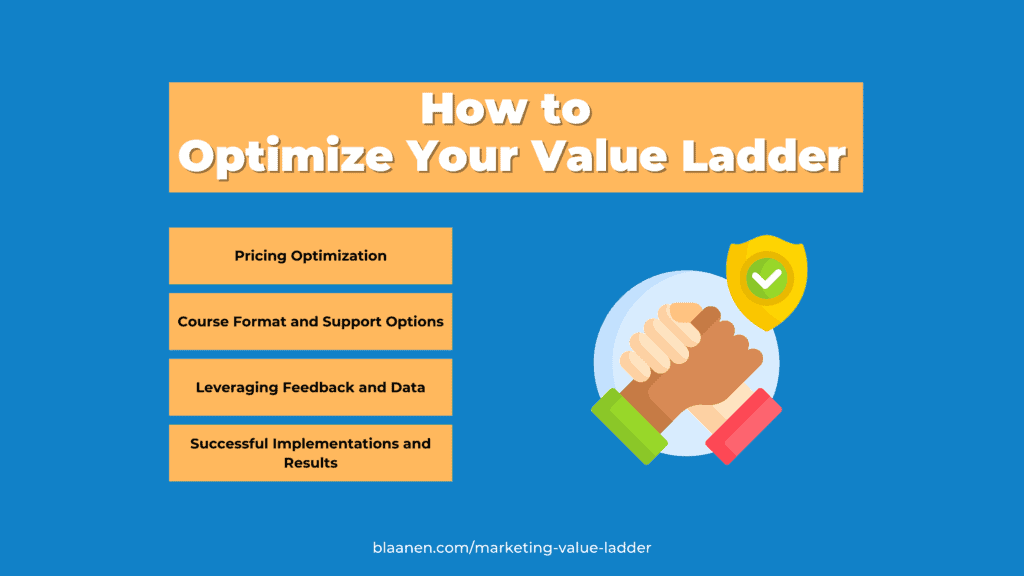
Pricing Optimization
Different price points play a crucial role in optimizing your value ladder. It’s essential to balance the pricing of your courses such that each step up the ladder offers noticeably more value, justifying a higher price. Higher priced items are usually placed at the top of the ladder.
Price optimization involves conducting thorough tests on various price points and offers to determine the most effective strategies for encouraging customers to increase their spending. It entails analyzing customer behavior, market trends, and competitor pricing to identify the optimal balance between value perception and revenue generation.
By experimenting with different pricing strategies and offers, you can uncover the pricing sweet spot that resonates with your target audience and maximizes customer spending.
Course Format and Support Options
Experimentation is key in the format of your courses. For instance, an introductory course might be more engaging as a self-paced online course, while a mid-level course might benefit from adding live webinars or group coaching sessions. Similarly, premium courses that offerone-on-one coaching or live events warrant a more immersive and personalized format.
Testing different formats and analyzing the response from your audience can help you fine-tune your offerings.
Support options can also greatly impact the value of your courses. For example, providing email support might be sufficient for an introductory course, while personalized feedback or direct interaction with the instructor could significantly enhance the value of your mid-level and premium offerings.
Again, testing different support options and gauging customer feedback will help you determine the best approach.
Leveraging Feedback and Data
Customer feedback, course analytics, and sales data should be your guiding lights as you optimize your value ladder. By closely monitoring completion rates, you can identify any potential issues in your course content that might be causing learners to drop off.
Sales data can show which courses are performing well and which might need adjustment. Direct customer feedback can provide invaluable insights into what your learners value, helping you align your offerings more closely with their needs and expectations.
Successful Implementations and Results
Successful optimization of a value ladder can significantly impact a business’s growth and profitability. For instance, MasterClass, a renowned online learning platform, has effectively used the value ladder to expand its customer base.
They offer an affordable all-access pass that gives learners access to all their courses, serving as an enticing introductory offering. They then upsell more specialized, interactive experiences like live workshops with industry experts.
By testing different formats and price points, and leveraging customer feedback, they’ve created a compelling and profitable value ladder.
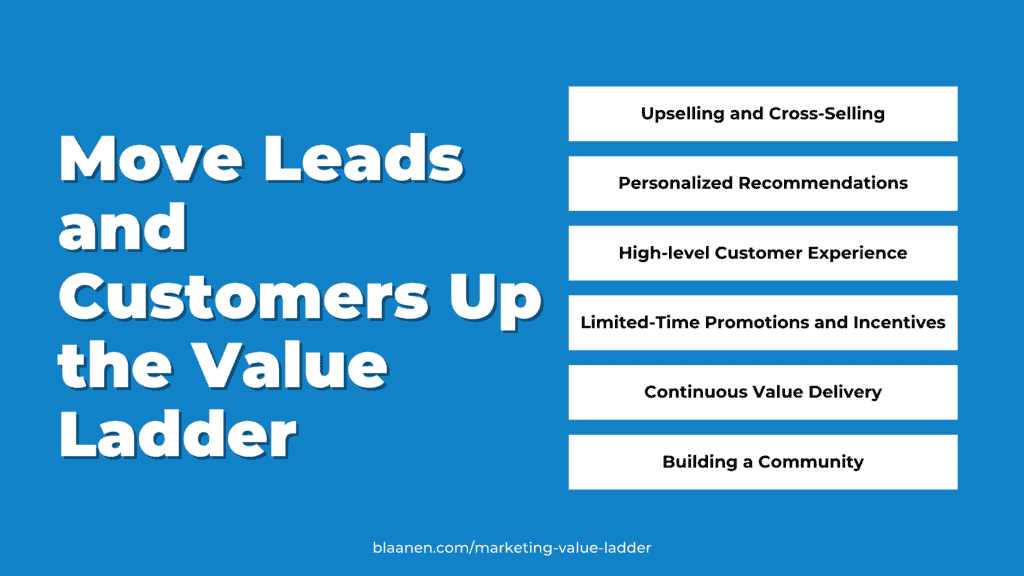
Here are six strategies to effectively move leads and customers up the value ladder:
- Upselling and Cross-Selling: Offer customers upgrades or complementary offerings that align with their initial purchase. Showcase the added value and benefits of these higher-priced items to entice them to invest more in their learning journey.
- Personalized Recommendations: Leverage customer data to provide tailored recommendations at the next level of the value ladder. Address their specific needs and demonstrate how the recommended product or service can further enhance their learning experience.
- High-level Customer Experience: Deliver exceptional customer support, engage with customers promptly and personally, and actively address their concerns or questions. By exceeding expectations, you build trust, loyalty, and satisfaction, encouraging customers to explore higher levels of your value ladder.
- Limited-Time Promotions and Incentives: Create a sense of urgency and exclusivity through time-limited promotions, discounts, or bonuses. Highlight the additional value and unique benefits they will receive. This motivates customers to take advantage of higher-priced offerings.
- Continuous Value Delivery: Ensure each step of the value ladder offers progressively higher levels of value, knowledge, and expertise. Continuously refine and update your offerings based on customer feedback to meet their evolving needs and expectations.
- Building a Community: Foster a sense of community among your customers through online forums, group coaching sessions, or exclusive events. Creating a supportive learning community enhances the overall experience and encourages customers to engage with higher levels of your value ladder.
By implementing these strategies, you can guide leads and customers on a journey of continuous learning and growth, maximizing their lifetime value to your business.
Free and Low-Cost Entry-Level Products – Best Practices
Free and low-cost entry-level products are pivotal in your value ladder. They provide an accessible way for prospective customers to engage with your brand and experience the value you provide. Overdelivering value at this initial stage can significantly enhance customer trust, satisfaction, and interest in ascending your value ladder.
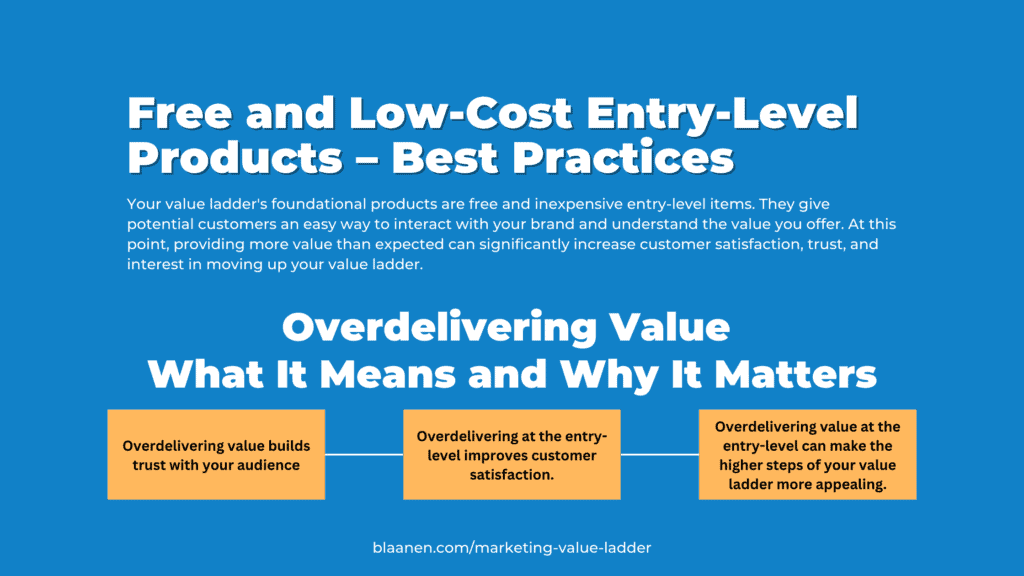
Overdelivering Value: What It Means and Why It Matters
Overdelivering value means going beyond what’s expected to provide an exceptional experience to your customers. At the entry-level stage, it could mean offering high-quality content, resources, or services that outperform your niche’s norm for free or low-cost products.
This practice is essential for several reasons:
- Overdelivering value builds trust with your audience. When you provide high-quality resources at a low cost or for free, you demonstrate your expertise and commitment to helping your audience succeed. This can foster a strong relationship between you and your audience, making them more likely to engage with your future offerings.
- Overdelivering at the entry-level improves customer satisfaction. When customers feel they’re getting more than they expected, it enhances their overall experience with your brand. This satisfaction can increase their loyalty, making them more likely to stay engaged and consider your higher-tier offerings.
- Overdelivering value at the entry-level can make the higher steps of your value ladder more appealing. If your free or low-cost offerings provide exceptional value, customers will be intrigued about the value they could gain from your mid-level, premium, or consulting offerings.
Essentially, overdelivering at the entry-level can be a powerful teaser for the rest of your value ladder.
Best Practices for Overdelivering Value On Initial Steps of the Value Ladder
Prioritize quality above all else to overdeliver value with your free or low-cost entry-level products. Ensure that even your free offerings are of the highest quality, providing your audience with real value and tangible results. This could involve creating a comprehensive ebook, an engaging video course, or a valuable toolkit relevant to your audience’s needs or interests.
Try to provide excellent customer support even at this entry level. Swift and helpful responses to queries or issues can enhance customer experience, further establishing trust and satisfaction.
Regularly update and improve your free or low-cost products based on customer feedback. This shows your audience that you’re committed to their success and continually strive to provide them with the best resources possible.
Conclusion
Throughout this article, you have explored the key aspects of a marketing value ladder for online course creators. I have emphasized the significance of providing value, building trust, and establishing expertise at each step of the value ladder, as these are essential for you to understand how it brings value.
I strongly encourage online course creators to take action and integrate a value ladder into their businesses. By implementing the marketing tactics outlined in this blog post, you can effectively promote your value ladder and attract a loyal customer base. Remember to consistently deliver high-quality content, engage with your audience, and provide exceptional value at each stage.
If you seek personalized advice on developing your marketing value ladder, please contact me, and we can find the best time for a free consultation. I and my team are here to provide you with tailored guidance and support.
FAQs About Marketing Value Ladder for Course Creators
1. How can I design consulting or coaching services that align with my expertise?
Start by identifying your target audience’s specific problems or challenges and determine how your expertise can address those issues. Develop service offerings that provide practical solutions, personalized guidance, and transformative outcomes.
Tailor your services to cater to different client needs, whether one-on-one coaching, group workshops, or strategic consulting sessions. Clearly communicate the benefits and outcomes of your services, emphasizing the unique value you bring to the table.
Continuously update and refine your offerings based on client feedback and market trends to ensure they remain relevant and impactful. By aligning your consulting or coaching services with your expertise, you can position yourself as a trusted authority and attract clients who are seeking your specific knowledge and support.
2. How does a marketing value ladder help attract and retain customers?
A marketing value ladder is a strategic framework that helps attract and retain customers by offering a progression of value and engagement. It allows you to cater to different segments of your target audience, accommodating their varying needs and budgets.
You attract potential customers and establish initial trust and credibility by starting with a lead magnet, such as a free e-book or webinar. From there, the value ladder guides them towards higher-priced offerings, such as introductory courses, mid-level courses, premium courses, or consulting services, providing increasing levels of value and personalized support.
This journey of ascending value encourages initial purchases and builds long-term relationships and customer loyalty. By consistently delivering value and exceeding customer expectations at each step, you can attract new customers, retain existing ones, and foster a community of satisfied and loyal learners.
3. How can I track and measure the success of my value ladder?
Start by defining key performance indicators (KPIs) that align with your business goals, such as conversion rates, revenue generated at each step, customer satisfaction ratings, or customer lifetime value.
Utilize analytics tools to gather quantitative data on website traffic, conversion rates, and customer behavior. Monitor engagement metrics like click-through rates, email open rates, and social media interactions.
Collect qualitative feedback through surveys, testimonials, and customer reviews to gauge customer satisfaction and identify areas for improvement. Regularly analyze and compare your KPIs over time to identify trends and measure the impact of any changes or optimizations made to your value ladder.
4. How can I price my premium course to ensure it’s perceived as valuable?
Consider the value proposition, the unique knowledge or skills you offer, and the transformation your course can provide to your customers. Research the market to understand the pricing of similar courses and the perceived value they provide. Determine your target audience’s willingness to invest in high-value learning experiences.
Consider factors such as the depth of content, the level of personalization and support, and any additional resources or bonuses included. You can use tiered pricing models, offering different levels with varying features or access, to cater to different customer segments.
Present your pricing with clear and compelling messaging that highlights the benefits and outcomes your premium course offers. Consider offering payment plans or limited-time discounts to create a sense of urgency and exclusivity.
5. How can I use case studies to promote my premium course?
Start by identifying past students who have achieved notable results through your course. Collect their stories, testimonials, and measurable outcomes highlighting their progress and achievements. Present these case studies compellingly, such as written testimonials, video interviews, or before-and-after transformations.
Incorporate these case studies into your marketing materials, including your website, sales pages, social media posts, and email campaigns. Use storytelling techniques to emphasize the challenges faced by your students, how your course provided the solutions, and the positive outcomes they experienced.

